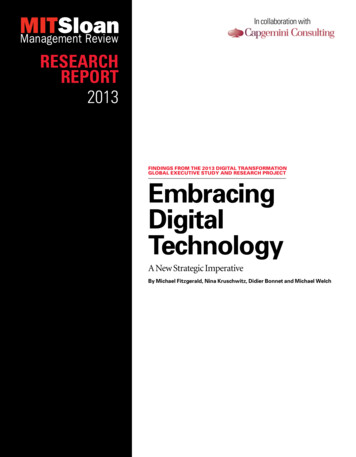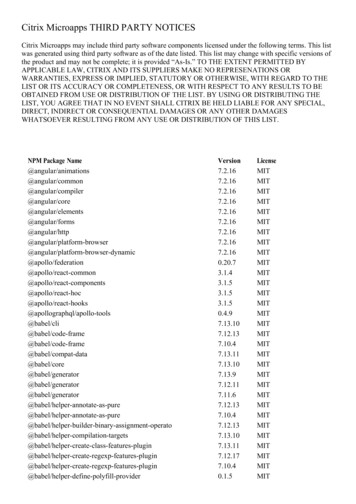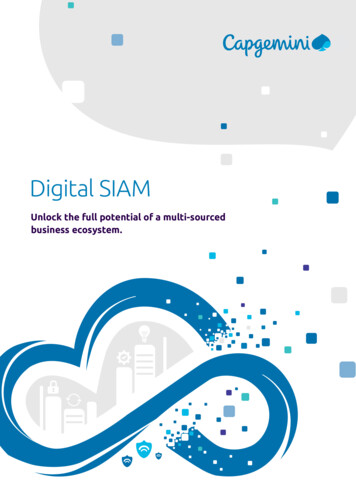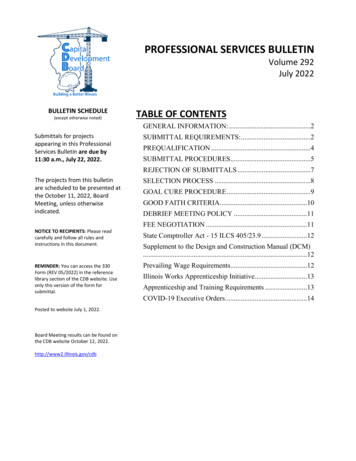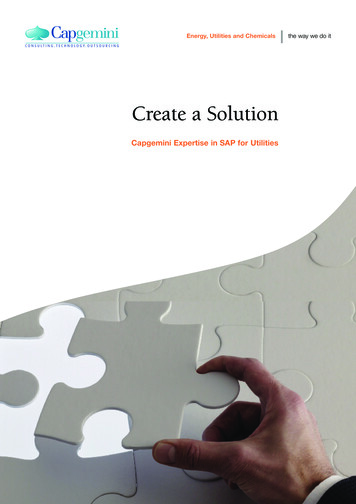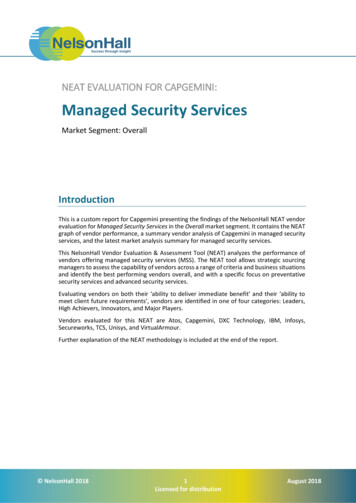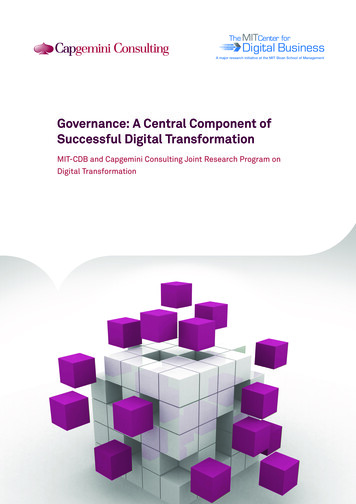
Transcription
101011010010101011010010101011010010A major research initiative at the MIT Sloan School of ManagementGovernance: A Central Component ofSuccessful Digital TransformationMIT-CDB and Capgemini Consulting Joint Research Program onDigital Transformation
IntroductionExecutives in all industries are using digital advances such as analytics, mobility, social media and smart embedded devices totransform their businesses. They are changing customer interactions, internal business processes and even their business modelsto take advantage of new technological capabilities. However, while digital technology presents new opportunities, it also createsnew challenges.Our research shows that governance is a key determinant of success in managing digital transformation. In this paper, we examinenew digital challenges, key elements of digital governance, and how four firms are governing their digital transformations.2
New Digital ChallengesFaster and MoreIntegrated BusinessCyclesMobileapps,collaborationnetworks, connected productsor social media create newbusiness opportunities from marketingto manufacturing to customer service.However, they also create new ITchallenges including security, regulatorycompliance and legacy system integration.An additional challenge comes frombusiness cycles that are getting faster andfaster.1Creating technology-based businesschanges quickly and safely requires IT andbusiness people to work together moreclosely. “We have a ‘two in a box’ model[for our digital initiatives]. We would behard-pressed to differentiate the businessperson and the technology person,”said one CIO, “Our challenge becomesmore and more the ability to work in afast paced, fast changing, global andcollaborative environment. It is not onlyabout technology skills anymore.”New RisksNew digital technologies also create newrisks to the enterprise, especially aroundbrand control and regulatory issues.Brand Exposure in Social MediaSocial media reduces a firm’s control overits global brand. A negative customerpost on Facebook, Twitter, or YouTubecan receive global attention immediately.Even as companies find new ways to workwith customers through mobile and socialDataintegration isthe biggestchallenge insetting upour digitalservices.channels,2 they are also paying closeattention to their online reputations.Confidentiality and Regulatory BreachesEmployee use of new digital technologiescan have firm-level consequences. Lostphones and tablets can enable hackersto invade a network. Employees maypost confidential information online.Customers may see employees’ personalposts as corporate advice on investmentsor health. Any of these breaches can leavefirms liable to reputational damage andmillions of dollars in regulatory sanctions.An insurance executive explained: “Weneed to approve any content publishedon our Facebook or LinkedIn accountsto make sure it is compliant with whatthe regulations require.” Security ofemployees’ devices is also a major concern:“If you lose confidential information, youhave to send letters to all of your clientsinforming them that their informationmay have been compromised” added thisexecutive. “The last thing we want to dois put the reputation that we’ve built for150 years on the line because of a securityincident.”Increased Demand forCross-Silo CapabilitiesNew digital technologies increase theneed for firm-level integration. Customersand employees are demanding thatcompanies work differently.3 Older silobased operations, centered on products ororganizational units instead of customersor business processes, are coming underincreasing pressure to change. Analyticsinitiatives require a unified view ofcustomers or operations.Integrated DataAs customers demand a more integratedexperience, and analytics demandsmore integrated data, many companiesare struggling to unify their disparatedata sources. “Data integration is thebiggest challenge in setting up our digitalservices” explained an executive, echoingstatements by many others.4 Thesefirms are working to develop a unifiedplatform for their digital initiatives, fromnew customer interfaces to automatedfactories to advanced analytics.Employee CollaborationAs firms become more global, theyare finding the need to collaboratemore effectively across geographies,business units, and specialties. Somenew collaboration tools, such as videoconferencing and instant messaging, havebeen adopted relatively quickly and easily.Others, such as online knowledge sharingcommunities, have been successful forsome and more challenging for others.3
Elements of Digital GovernanceTo answer these new digital challenges (faster business cycles, new risks and need for more firm-level integration), companies needfirm-level governance around their digital initiatives.“Digital impacts firms globally, across traditional silos. It requires more coordination when making decisions and conducting actions,compared to the way we do business usually. Questions are not local but global and so the choices we make engage the company as a whole,in all countries and business units,” explained a senior executive in an international banking group.Governance mechanisms implemented by companies around their digital initiatives have impacts of two different natures: Sharing: Local units use common capabilities and resources (including people and technology) Coordinating: Local units synchronize and align their initiatives (prioritization, compliance with standards and policies, etc.)Our interviews showed many mechanisms that companies are using to improve their digital governance capabilities. However, threemechanisms – shared digital units, firm-level committees and new digital roles – are most common.Shared Digital UnitsSeveral of the companies created sharedunits to develop digital services for therest of the company. The responsibilitiesof these shared units vary from onecompany to another, but many includedthe following roles.Developing Digital ServicesShared units can reduce the cost ofdigital transformation through reducingredundant initiatives, people andtechnologies in the local units. A seniorexecutive in a global insurance groupexplained: “It would not make sense for thedifferent entities of the group to develop allthe digital stuff themselves. It costs timeand money, and requires coordination.And by doing it themselves, they would notbenefit from the experience gained acrossthe company.”Several companies created a “digitalservice catalog” to show local unitswhat the shared unit can offer. Beyondfacilitating communication, the cataloghelps early adopters to avoid redundantactivity and helps later adopters to movefaster.Shared units can also undertakecorporate-wide investments that mightnot make sense for individual businessunits. Examples include unified customerdatabases, an enterprise wirelessplatform, or advanced analytical tools.4A senior executive in charge of digitaltransformation for his business unitexplained: “We do not have budgetto develop our own capabilities so thequestion is: How to get the most out of thecentral platform? How to leverage thesecapabilities as much as on capabilities to spurinnovation.In an apparel company,a retail firm, and a consumer foodcompany, digital labs investigate emergingtechnologies and business practices.These small labs turn abstract conceptsinto real prototypes that spur others torethink the way they do business. Businessunits can incorporate the concepts intotheir subsequent digital initiatives.Developing New Digital SkillsIn our phase 1 study, the most importantcommon barrier to digital transformationwas missing skills. 77% of the companiescited skill challenges in areas such asmobility, analytics, and social media.They are actively recruiting expertsin these areas, with varying degreesof success. Several of the firms havechosen to centralize new digital skillsDigital impacts firms globally, acrosstraditional silos. It requires morecoordination when making decisionsand conducting actions, compared tothe way we do business usually.Questions are not local but globaland so the choices we make engagethe company as a whole
in the shared unit. “Of course, the keything is to have the right people. It mustbe a combination of our existing peopleand new people with new thoughts. Andlooking at service industries, we need thattype of competence,” explained an autoexecutive.5Although some industries are havingtrouble finding experts at reasonablesalaries, others are more successful atattracting talent. A restaurant executivenoted “We have been hiring analyticsexperts from other industries. We givethem a chance to play a more seniorrole than they could in their previousemployers, where their skills are moreplentiful.” An apparel executive said “Ourdigital unit recruits people from Amazonand other places you would expect them togo quite a talent!”Training and knowledge sharing is anotherway that digital units build skills acrossthe enterprise. At Nestlé, a multimedialab named “Digital Acceleration Team”hosts experts from all over the world sothat they can share their knowledge insocial media and related technologiesbefore going back to their local offices.The firm adopted the same approach formobile applications: “[We have] a mobileApp lab where we share best practice ofbuilding Apps. We don’t want to centralizethe app building, we leave that close tothe consumer in the markets. But there’scommon practice, best practice, efficientapp building and we have a lab for thatso people can tap into it and we can guidethem in making good Apps.” 6Governance CommitteesMany of the companies we interviewedestablished committees at firm-level togovern digital transformation. Steeringcommittees are a common structure.However, some companies have alsoestablished innovation committees to stayahead of fast-moving digital technologiesand business practices.Steering CommitteesThe adoption of digital technologies raisesquestions for executives such as: How dowe prioritize and fund digital initiatives inspite of unclear business cases? How dowe allocate resources? What policies dowe need to ensure regulatory compliance?What rules should we adopt internally toensure a consistent customer experience?What should be done centrally and whatshould be done locally? The role ofsteering committees is to make thesedecisions: ratifying policies, makinginvestment choices, and prioritizingamong competing interests.Steering committees also make investmentdecisions that might not be practical for aspecific business unit to undertake. Somedigital initiatives will be shared acrossbusiness units or are strategic bets withuncertain business cases. An example is anapparel company’s investment in a globalcustomer platform: “This investmentwas primarily based on what I would callan ‘art business case’, rather than the‘science business case,’ and this was theright thing to do. We did it big enough tobe successful, but small enough to not bestupid” explained a senior executive.This investmentwas primarilybased on what Iwould call an ‘artbusiness case,’rather than the‘science businesscase,’ and thiswas the rightthing to do. Wedid it big enoughto be successful,but small enoughto not be stupid.Innovation CommitteesSome companies also implementedcommittees around emerging technology,both to identify technology-enabledbusiness opportunities and to adjustto changing employee or customerbehaviors.At Nestlé, a multimedia lab named the ‘Digital AccelerationTeam’ hosts experts from all over the world so that they canshare their knowledge in social media and relatedtechnologies before going back to their local offices.5
These committees are less common thansteering committees, and have a morefocused purpose.According to an insurance executive,“We cannot be slow to think about thesetechnologies because our field force adoptsthem quickly. We have regulatory concernsthat we have to deal with, we have gottraining and education challenges. Weneed people with different perspectivestalking together about these emergingtechnologies.”Having people with multiple disciplinesimproves the discussion and leads totighter integration between IT andbusiness viewpoints. An executiveexplained: “We are bringing together allthe people who can say, ‘Wow, we coulddo this. It’s not a problem.’ That’s our ITarchitecture folks. And then we’ve goteverybody else saying ‘Well, if we do this,how do we protect confidentiality? How dowe retain data? How do we train? What’sit going to take to make this usable beforewe officially condone it to the field?’ So, ITbrings all of the right levels of perspectiveto the table.”New Digital RolesGovernanceoftengoesbeyondorganizational structures to includespecific leaders. These new rolesinclude “digital czars” who lead digitaltransformation at the firm or businesslevel as well as less senior liaison roles.Digital CzarsIn March 2012, Starbucks Coffee Companyannounced the hiring of a Chief DigitalOfficer (CDO), Adam Brotman, reportingto the firm’s CEO. According to Brotman,“[Digital] has been an essential part of howwe build our brand and connect with ourcustomers there’s been such a seismicshift [in our interactions with customers]that we needed to pull it all together andmake it a priority.”76Areas of responsibility for these “digitalczars” vary from one company to anotheraccording to the strategic priorities of thefirm towards digital. Brotman at Starbuckshas responsibility for web, mobile,social media, card, loyalty, e-commerce,Wi-Fi, and the Starbucks Digital Network,as well as company’s emerging in-storedigital and entertainment teams. AtVolvo the firm hired a senior executiveto take responsibility for a specific newelement of the firm’s digital strategy —connected cars — across different silossuch as product design, manufacturing,marketing, and after sales service.Digital LiaisonsSome of the companies we interviewedhave positioned liaisons in businessunits to lead digital transformation at alocal level. Spanish media group Prisa,has assigned CDOs in each divisionto lead implementation of the digitaltransformation in their division and tocoordinate with the corporate CDO. Aglobal insurance group executive saidthat, in his company, “The role of [digitalliaisons] is first to help business units totake the digital dimension into accountand second to encourage the use of centralresources.”Some liaisons have knowledge sharingrather than leadership roles. Nestlé’s“Digital Acceleration Team” hosts peoplefrom all countries to develop their digitalexpertise and take it back to their homeoffices. “We have something like 15people, from all markets, who have aninterest or have already good experiencein digital, who are sharing and connectingwith the world in general with the Internetand social media. They are buildingexpertise and then sharing that with otherpeople in the markets.”8Governanceoften goesbeyondorganizationalstructures toinclude specificleaders. Thesenew rolesinclude “digitalczars” who leaddigitaltransformationat the firm orbusiness levelas well as lesssenior liaisonroles.
The table below summarizes how these three governance mechanisms help sharing and coordination, and shows common benefitsand implementation challenges we identified in our interviews. In the next chapter, we give examples of how four companies areimplementing digital governance.Table 1: Common Digital Governance MechanismsRole in sharing and coordinationShared DigitalUnitsSharing is the main objective of these units. Resourceswith specific skills are pooled together to develop digitalservices for all units in the company. Some coordinationalso comes naturally as the units develop technologystandards and implement policies governing use of theirservices. However, coordination of digital initiativesrequires additional mechanisms.Benefits: New digital skills, shared digital services,economies of scale.Firm-level committees aim for coordinationBenefits: Digital standards and policies, consistency acrossdigital initiatives, resource optimization, adoption of newdigital trends. Steering committees: Making investment decisions,prioritizing resources, ratifying policies and standards.Firm-LevelCommitteesTypical benefits and challenges Innovation committees: Identifying technology-enabledopportunities, proposing rules and standards aroundnew technologies.Challenges: Structure and positioning in the organization,coordination difficulties with local unit leaders, definition ofthe “service catalog.”Challenges: Additional mechanisms are often required tolead transformation or to enforce standards and policies.However, some of the decisions and policies adopted bythe committees may mandate sharing of resources andcapabilities.New DigitalRolesNew digital roles drive the use of shared digital resources,such as helping local units to adopt firm-level solutionsor use centralized resources. These roles also coordinateacross different initiatives and organizational units.Benefits: Relay the digital strategy, help to enforce firmlevel policies, facilitate adoption of shared capabilities bylocal units, facilitate cultural changesChallenges: Positioning in the organization, relationship withthe local units, building the networks of local champions.The Importance of Digital PlatformsAn important objective of governance is to make enterprise-level platforms happen. It can be very difficult to build a singleview of customers or an integrated view of operations without strong leadership and governance. The platforms provideclearer information to decision-makers and serve as the bases for advanced analytics capabilities and new digital services.In return, these platforms tend to make governance easier: as the platforms take shape, local leaders often start to see thebenefits of using corporate digital capabilities rather than building their own. And corporate leaders can drive standardprocesses and capabilities across the firm more quickly through a shared platform than through negotiation.7
Case Studies in Digital GovernanceCompanies design their digital governance to achieve different levels of coordination and sharing (see Figure 1). In the rest ofthis chapter, we describe four case vignettes, illustrating how each company implemented governance mechanisms to achieveits coordination and sharing objectives.“InvestCo:” Executives, experiencing difficulties with localized governance of digital initiatives,have begun to implement stronger governance at the corporate level.Volvo Car Corporation: Implementing digital governance for a specific new capability: connected cars.“ApparelCo:” A shared digital unit helps the firm harness the full potential of digital transformation.PRISA: Using digital governance to transform the company’s global operating model.Figure 1: Level of coordination and sharingHigh4Level of sharing32Note: For each case vignette below, a small figureillustrates the governance structure implemented bythe firm. These figures are illustrative only and donot reflect the formal organization of the firms.1LowLow8Level of coordinationHigh
InvestCo: Challenges of Diversified GovernanceE-Commerce & AnalyticsUnit /RegionUnit /RegionUnit /RegionUnit /RegionContextInvestCo provides investment products and services to individuals andinstitutions in over 40 countries. Although much of the firm’s management anddecision making has been centered around its headquarters, the company’sbusiness units operate highly autonomously. Recently, globalization and newdigital business opportunities have triggered changes in the way the firmgoverns its technology initiatives.Legend:Technologyplatforms (in progress)Internally, employees use instant messaging and video conferencingextensively to collaborate both in headquarters and across global regions. Onthe customer facing-side, the company is increasing self-service and upgradingits online information resources as well as experimenting with social media.Most digital initiatives have historically been managed separately. Business-unit autonomy has led to a digital platformin which systems are not unified. However, globalization, customer requirements and regulation are raising pressures tointegrate information across business units and regions.Governance MechanismsHistorically, InvestCo had no digital governance beyond the decentralized governance used for IT. In approximately 2010,the executive team started to rethink their approach. The change began by linking IT and operations more closely at theglobal level. This enabled a more integrated approach to defining global processes, setting the stage to transform thecompany’s many IT systems into a unified global platform. Recently, governance has been extended to include new digitalinitiatives such as social reputation monitoring, micro-blogging, video promotions and mobile selling.Platforms and BenefitsThe intent of transforming the firm’s platform was to answer a growing demand for unified systems and information. Thechange is expected to generate economies of scale and reduce time-to-market. In addition, executives want strongeranalytics capabilities. The head of global IT applications explained: “There is a lot of focus on gaining intelligence.This trend is clearly happening across all the businesses.”Technology capabilities are also intended to improve technology sharing across business units and regions. The head ofe-business said, “There may be somebody in another office working on something we could benefit from, and if we worktogether, we can lighten the workload. So, we can pool money and resources if we work on the same types of effort. Thatworks sometimes, and sometimes it doesn’t because the requirements are too different. But we all collectively believe that,in the end, it will help us.”If we work together, we can lighten the workload. So, wecan pool money and resources if we work on the sametypes of effort.9
Volvo Car Corporation: Governing Specific Digital Capabilities9Shared Digital UnitAnalytics, CRM, DatabasesUnit /RegionUnit /RegionUnit /RegionUnit /RegionLegend:TechnologyPlatformsSharedDigital unitFirm-LevelCommitteesDigital CzarContextVolvo Car Corporation relies on a network of 2300 local dealersto sell its cars in 100 countries worldwide. Headquartersmanufactures cars and conducts market research about classes ofcustomers, but has little direct knowledge of specific customers.In recent years, however, the firm has begun building a new digitalbusiness model — connected cars — to augment its existingbusinesses. The intent is to develop a more direct relationship withthe end customer without disrupting the relationship dealers havewith them.The connected cars concept enables Volvo to offer more servicesto customers (remote control, roadside assistance, maintenancereminders, etc.), and develop new approaches to marketing toconsumers. Volvo also expects to reinforce the link between endcustomers and local dealers through increased loyalty, and drivingcustomers to dealers for additional services.Governance MechanismsWhile Volvo’s traditional governance mechanisms were sufficient to manage most activity in the company, Volvo executivesestablished a separate set of governance mechanisms for the connected cars concept. Digital Czar: Designing an effective connected-cars experience for end-customers requires strongcoordination between marketing, manufacturing, R&D, sales and other entities that had differentrelationships for Volvo’s traditional B2B focus on relationships with dealers. To take up this challenge,the firm hired a senior executive in charge of connectivity across traditional silos such as manufacturing,after-sales services or marketing. Firm-Level Committees: A “Connectivity Hub,” composed of middle and senior managers from across the company(including R&D, marketing and IT), meets every week to address tactical decisions. The “Connectivity Committee,”composed of senior executives from the different functions, meets quarterly to address strategic topics. Othercommittees exist to ensure strong alignment between connectivity teams and technology teams such as mobile appsand innovation. Shared Unit: Volvo has also established a shared technology support unit whose scope extends beyond theconnectivity strategy.Platforms and BenefitsVolvo has already released new connectivity services such as remote control or on-road assistance. Although someelements such as roadside assistance call centers are implemented locally, all operate under global framework agreements.Internally, Volvo implemented new technology platforms to improve customer knowledge and improve marketingcapabilities. The platforms include customer databases, analytics capabilities and a CRM solution. “We now have muchbetter data: who our customers are, which cars do they own, how long have they owned their cars, how often they go toservice, how much they spend on their car. Instead of maybe targeting towards the cars in different car segments or modelsegments, we’ll use the data to segment the customers into different customer segments. Then we’ll actively go from massmarketing to one-to-one marketing” explained Timo Paulson, Senior Manager Ownership Services and Brand Protectionfor VCC global.The firm hired a senior executive in charge of connectivityacross traditional silos such as manufacturing, after-salesservices or marketing.10
ApparelCo: Developing a New Digital UnitShared Digital UnitEcommerce, Collaboration, DatabasesUnit /RegionUnit /RegionUnit /RegionUnit /RegionLegend:TechnologyPlatformsSharedDigital unitFirm-LevelCommitteesDigital CzarContextApparelCo is a global manufacturer of clothing, footwear andsportswear. The firm has built its successful business by combininggood products with compelling branding. Its entrepreneurial spirithas led to growth in product silos, and digital initiatives have beenundertaken separately from each other.ApparelCo uses its website and new social media capabilitiesextensively to engage with customers. E-commerce includes someadvanced customization possibilities. The firm is also developing arange of “digitally-improved” products.Digital technologies are also widely used internally. Productdesign moved from paper to digital, the company increased itsdigital integration with suppliers, and several corporate functionsestablished platforms to improve global collaboration. Althoughmany of the digital initiatives were effective, they were managedseparately from each other.Governance Mechanisms Shared Digital Unit: ApparelCo created a shared unit to deliver all digital capabilities for the firm. The digital unitis in charge of digital platforms and provides services to assist the company in developing digital capabilities suchas mobile apps. It also develops and sells some digital or digitally-improved products. Rules have been definedto clearly state the areas of responsibility of the unit, especially towards marketing and communication. Digital Czar: The head of the shared unit is in charge of digital business and all digital marketing campaigns forthe company. Part of the czar’s role is to help the business units (product lines) to leverage digital commercecapabilities as much as possible. Firm-Level Committees: A steering committee drives digital strategy and monitors progress. Senior executives ofall functions are part of this committee. In addition, each major product line, as well as the digital unit, has aninnovation group. These groups identify new ways to use digital technologies to improve products.Platforms and BenefitsA key objective of digital governance – and the digital unit – at ApparelCo is to shift from product-centricity to customercentricity. “We have evolved the organization drastically to make sure that we can create one digital voice, one digital focus.We’re focusing not only internally but also, more importantly, externally to our consumers” explained a senior executive.To improve customer intimacy, the firm invested in a consolidated platform for customer-facing activities. Internally, thefirm replaced the multiple existing collaboration platforms by one firm-level solution. An executive explained: “Now, aswe move forward in the collaboration space at corporate level, it is unified instead of being separate solutions offered bydifferent business units for internal work.”We have evolved the organization drastically to make surethat we can create one digital voice, one digital focus.11
PRISA: Digital Governance to Transform the Organization10Shared Digital UnitContent Management, MonetizationUnit /RegionUnit /RegionUnit /RegionUnit eesSharedDigital unitDigital CzarNetwork ofLocal RelaysContextPRISA is a Spanish-language-based global media organizationwith businesses spanning television, press, radio and educationalpublishing. As with many media organizations, PRISA was facedwith a rapid transition to digital in most of its core businesses, anda move away from more traditional media.PRISA executives challenged the organization not only to adoptdigital media in its many media properties, but also to use digitaltechnology to improve collaboration across the properties.The digital transformation vision had four key pillars: creating afederated digital organization, creating a next generation digitaldistribution and monetization platform, injecting new digitalskills and experience from outside the company, and encouragingdigital innovation in the business lines.Governance Mechanisms Shared digital unit: The CEO instituted a radical change for the highly decentralized organization by creatinga centralized digital unit to coordinate and assist in building digital businesses. This shared unit encompassesseveral economic models. Kamal Bherwani, Group Chief Digital Officer, explained: “PRISA Digital does innovationas an investment model. The digital sales strategy is a P&L model and ‘PRISA Servicios Digit
with customers through mobile and social New Digital Challenges 3 Data integration is the biggest challenge in setting up our digital services. channels,2 they are also paying close attention to their online reputations. Confidentiality and Regulatory Breaches Employee use of new digital technologies can have firm-level consequences. Lost

